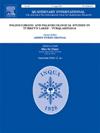Tectono-sedimentary evolution of a marginal fault: Insights from the Dead Sea Transform Fault System
IF 1.9
3区 地球科学
Q3 GEOGRAPHY, PHYSICAL
引用次数: 0
Abstract
The Dead Sea Transform (DST), a prominent tectonic feature on Earth's crust, provides an exceptional natural laboratory for investigating the dynamic processes associated with continental rifting and its subsequent evolution. This study focuses on the sedimentary and tectonic evolution of the Yesha Fault, a marginal fault of the DST. Along the Yesha Fault, a distinct, elongated depression, known as the Yesha Valley was formed. Through detailed analysis of sedimentary sequences from boreholes and geochronological data obtained by optically stimulated luminescence and magnetostratigraphy, this research aims to refine the understanding of sedimentation patterns, rates, and tectonic activity associated with this marginal fault. The initial formation of the Yesha Valley, postdating the Brunhes-Matuyama reversal (∼773 ka), was driven by normal faulting, resulting in an accommodation space progressively infilled with clastic and aeolian sediments. The sedimentary record reveals four distinct cycles of calcic soil between ∼780 ka and ∼450 ka, indicative of short episodes of tectonic subsidence, each followed by a period of tectonic quiescence, during which carbonate accumulated and calcic soils have developed. Following ∼450 ka, the sedimentary sequence accumulated in the subsiding valley lacks evidence of abrupt tectonic events, suggesting a transition to a tectonic regime dominated by gradual creep. During the last glacial period, sedimentation is characterized by clay deposition, with more hydric conditions and increased organic content observed between 4 and 6.5 m, whereas the uppermost 2 m of the soil reflects the influence of recent anthropogenic activity. Sediment accumulation rates within the Yesha Valley exhibit considerable variability, ranging from 20.8 cm/ka to 1.8 cm/ka, with an average of 3.2 cm/ka. These rates are an order of magnitude lower than those observed in the adjacent Hula Basin, indicating a slower tectonic regime along the marginal Yesha Fault and valley.
死海转换断裂系统对边缘断裂构造-沉积演化的启示
死海变形(DST)是地壳上一个突出的构造特征,为研究与大陆裂谷及其后续演化相关的动态过程提供了一个特殊的自然实验室。本文研究了东西向边缘断裂叶沙断裂的沉积构造演化。沿着叶沙断层,形成了一个独特的细长凹陷,被称为叶沙谷。通过对钻孔沉积序列的详细分析,以及光激发光和磁地层学获得的地质年代学数据,本研究旨在完善对与该边缘断裂相关的沉积模式、速率和构造活动的认识。叶夏谷的初始形成是在布鲁内斯-松山反转(~ 773 ka)之后,由正断层作用驱动,导致一个容纳空间逐渐被碎屑和风成沉积物填满。沉积记录显示,在~ 780 ka ~ ~ 450 ka之间有四个不同的钙质土壤旋回,表明构造沉降的短暂期,每一次都有一个构造静止期,在此期间碳酸盐积聚和钙质土壤发育。在~ 450 ka之后,沉降谷中积累的沉积序列缺乏突发性构造事件的证据,表明向以逐渐蠕变为主的构造体制过渡。在末次冰期,沉积以粘土沉积为特征,在4 - 6.5 m之间观察到更多的水化条件和增加的有机含量,而土壤最上层2 m则反映了最近人类活动的影响。叶沙河谷的沉积物堆积速率表现出相当大的变异性,在20.8 ~ 1.8 cm/ka之间,平均为3.2 cm/ka。这些速率比邻近的呼拉盆地低一个数量级,表明叶沙断裂和山谷边缘的构造状态较慢。
本文章由计算机程序翻译,如有差异,请以英文原文为准。
求助全文
约1分钟内获得全文
求助全文
来源期刊

Quaternary International
地学-地球科学综合
CiteScore
5.60
自引率
4.50%
发文量
336
审稿时长
3 months
期刊介绍:
Quaternary International is the official journal of the International Union for Quaternary Research. The objectives are to publish a high quality scientific journal under the auspices of the premier Quaternary association that reflects the interdisciplinary nature of INQUA and records recent advances in Quaternary science that appeal to a wide audience.
This series will encompass all the full spectrum of the physical and natural sciences that are commonly employed in solving Quaternary problems. The policy is to publish peer refereed collected research papers from symposia, workshops and meetings sponsored by INQUA. In addition, other organizations may request publication of their collected works pertaining to the Quaternary.
 求助内容:
求助内容: 应助结果提醒方式:
应助结果提醒方式:


